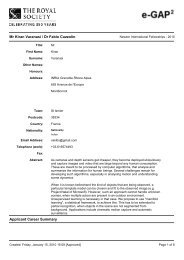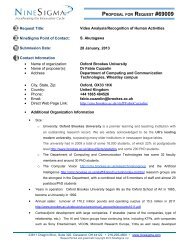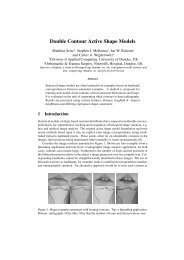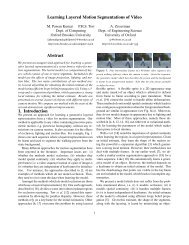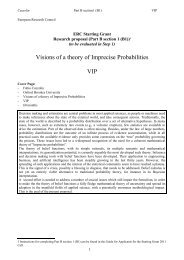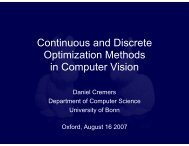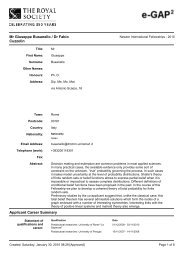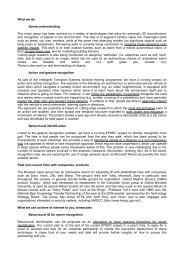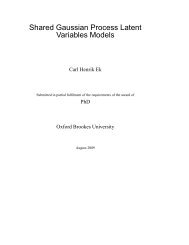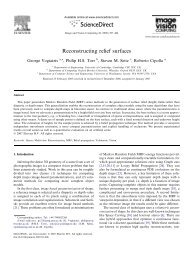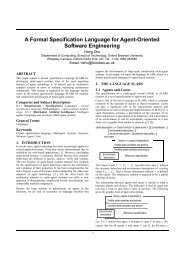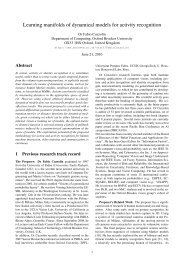Project Proposal (PDF) - Oxford Brookes University
Project Proposal (PDF) - Oxford Brookes University
Project Proposal (PDF) - Oxford Brookes University
You also want an ePaper? Increase the reach of your titles
YUMPU automatically turns print PDFs into web optimized ePapers that Google loves.
FP7-ICT-2011-9 STREP proposal<br />
18/01/12 v1 [Dynact]<br />
maximise the impact of the project: the creation of new baseline algorithms could considerably<br />
enhance the visibility of the latter;<br />
make the datasets gathered in the course of the project publicly available as new benchmarks to the<br />
academic community, in this way boosting the visibility of the whole enterprise; these datasets will<br />
be either downloadable via FTP server or by direct shipping via external USB hard drive;<br />
launch grand challenges on the various scenarios which will be investigated throughout the project;<br />
attract new industrial and academic partners with the goal of setting up patents or industrial<br />
partnerships;<br />
attract new academic partners to kick-start follow-up projects at national or European level.<br />
3.2.3 Timescales<br />
Realistic timescales for the benefits discussed in Section 3.2.1 will vary with the specific target.<br />
In terms of academic impact, a first round of conference publications should be ready at the end of the first<br />
year, while journal articles will likely take two or three years to reach publication stage. The use of vehicles<br />
such as special issues of international journals linked to consortium partners could help to speed up the<br />
process.<br />
Industrial involvement is built-in the proposed project, thank to the presence of DYNAMIXYZ with its<br />
infrastructure and network of industrial relations. However, other partners will be sought to further increase<br />
impact as explained exhaustively above.<br />
Existing links will take no time to be activated when the consortium deems appropriate to do so. As<br />
previously argued, new industrial links are already being explored: this activity will continue throughout the<br />
project. The same can be said of intermediate entities and organisations.<br />
To start seeing commercial applications to biometrics or surveillance proper, initially in a limited context<br />
such as for instance biometric access, an additional two to three years of R&D after the end of the proposed<br />
research might be needed, possibly in partnership with a company specialised in this area. It is safer to<br />
assume a longer time scale when targeting a wider application to security in public areas: government or<br />
agency support will in this case be crucial.<br />
The timescale for benefits to the wider public basically depends on how quickly the developed techniques<br />
can be integrated in actual entertainment products (consoles) or search engines. Within the gaming scenario,<br />
OBU's existing industrial partners such as Sony could much contribute to speeding up the dissemination of<br />
the results and the necessary technology transfer.<br />
As for video retrieval, we envisage a potentially much swifter dissemination process due to fact that no<br />
expensive equipment of sort is needed. Furthermore, Dr Cuzzolin's personal contacts at Google could be put<br />
to good use to test our algorithms on the field.<br />
The engagement of other academic partners at national or European level will be kick-started in the second<br />
half of the project, in order to be ready for the preparation of follow-up proposals before the end of the<br />
current one. However, as already pointed out, an extensive network of contacts is already at work and could<br />
be activated in no time.<br />
3.2.4 Intellectual Property management<br />
Intellectual Property Rights management and exploitation will be managed (in close contact with the<br />
Coordinator and the Administrative Manager) by the Research and Business Development Office (RBDO) at<br />
<strong>Oxford</strong> <strong>Brookes</strong> <strong>University</strong> (OBU), which has access to financial and other resources to enable Intellectual<br />
Property and its commercial exploitation to be effectively managed, whilst maximising the widespread<br />
dissemination of the research results. This includes, as appropriate, finance for patenting and proof of<br />
concept funding; Intellectual Property, technology and market assessment; resources for defining and<br />
implementing a commercialisation strategy though licensing, start-up company or other routes.<br />
RBDO has a strong track record of commercialisation of its intellectual property. Income from licences was<br />
£1.5M in 2011 and this ranks the <strong>University</strong> in the top 10 in the UK of all universities for royalty income.<br />
OBU through RBDO holds a total portfolio of 20 patents. The <strong>University</strong> also supports the creation of spin<br />
out companies when appropriate and has some successful examples.<br />
If the outcome of the project in terms of implementation (see workpackage 5) will meet our expectations, we<br />
will consider the possibility of patenting the associated systems and algorithms.<br />
<strong>Proposal</strong> Part B: page [60] of [67]



